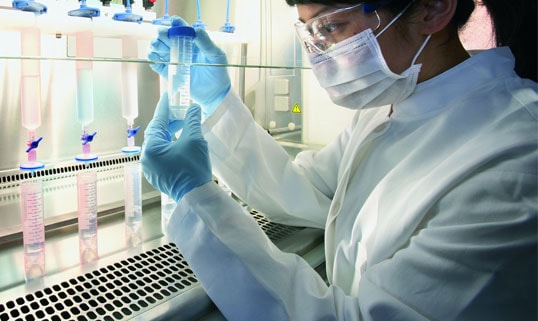Monoclonal anti-human NIS antibody (affinity purified)
- 100 ul / Standard (REA011-STAN) $ 495
Description: Affinity purified mouse monoclonal antibody to human NIS
Antigen: Synthetic peptide NEDLLFFLGQKELE corresponding to residues 598–621 of the human sodium iodide symporter, hNIS.
Detects both the native and denatured forms of human NIS. This antibody recognizes 14 residues at the C-terminus of hNIS. This antibody does not detect mouse NIS.
Host Species: Mouse
Isotype: IgG
Concentration: 1.2 mg/mL
Species reactivity: Human
Tested Applications (see references below):
- Immunohistochemistry (1:5,000 to 1:10,000 dilution)
- Flow Cytometry (1:500 dilution)
- Western Blotting (1:3,000 to 1:5,000 dilution) Refs: 1
Selected Product References:
1. Tazebay et al. 2000. Nat Med. 6: 871-878
All testing were performed by scientists at Imanis Life Sciences.
Immunoblotting for human NIS protein:
Membrane protein (10 μg; lanes 1-2) or total protein (50 μg; lanes 3-5) was subjected to SDS-PAGE and immunoblotting using monoclonal anti-hNIS antibody (1:3000) and HRP-conjugated anti-mouse secondary antibody (1:5000). Samples: humans NIS (lanes 1 and 4); murine NIS (lanes 2 and 5); negative control lysate (lane 3). Various glycosylated forms of human NIS are detected.
Flow cytometry:
(Left) Parental HeLaH1 cells or (Right) HeLaH1 cells stably expressing hNIS linked to enhanced green fluorescent protein (GFP) were fixed, permeabilized, and stained with monoclonal anti-hNIS antibody (1:500) followed by an Alexa Fluor 594-conjugated anti-mouse secondary antibody (1:1000). Samples were analyzed by flow cytometry.
Immunohistochemistry:
Tissue sections were deparafinized. Slides were subjected to antigen retreival using 10% citrate buffer. a, NIS expression of normal ductal–lobular units in the vicinity of breast cancer assessed with monoclonal antibody against NIS is shown above (magnification, X160). b, Ductal carcinoma stained with monoclonal antibody against NIS (magnification, x66).




